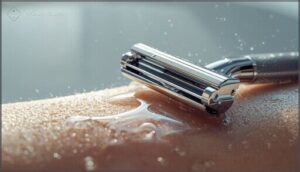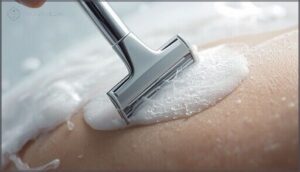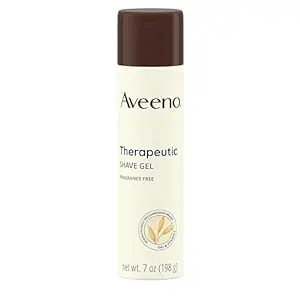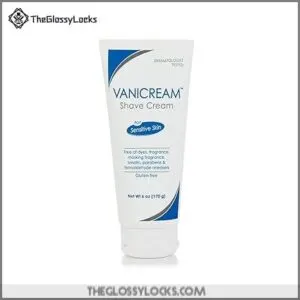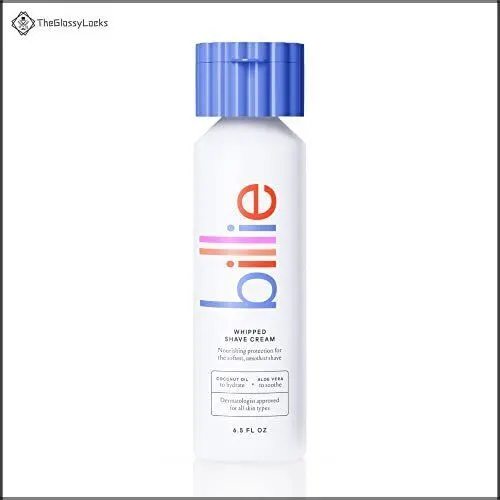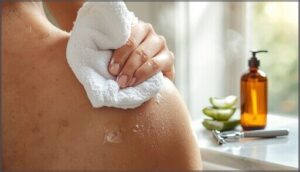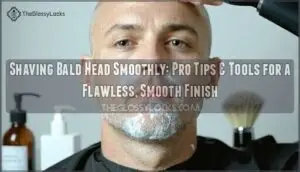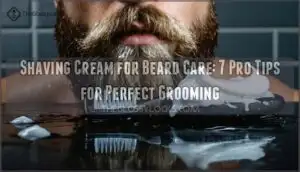This site is supported by our readers. We may earn a commission, at no cost to you, if you purchase through links.
Your skin doesn’t have to rebel every time you pick up a razor. While over 40% of people with sensitive skin report post-shave redness and irritation as their top grooming complaint, the culprit isn’t your skin type—it’s usually your technique.
The difference between a smooth shave and an inflamed mess comes down to three controllable factors: preparation, pressure, and product choice. When you soften hair properly before the blade touches your face, follow the natural direction of growth instead of fighting it, and choose formulations that support rather than strip your skin barrier, you eliminate most causes of razor burn and ingrown hairs.
Getting a clean, comfortable shave on sensitive skin isn’t about toughing it out or accepting irritation as inevitable—it’s about working with your skin’s biology instead of against it.
Table Of Contents
Key Takeaways
- Shaving irritation comes from three controllable factors—preparation, pressure, and product choice—not your skin type, so soften hair with warm water before shaving, use light pressure with the grain, and choose fragrance-free formulas that protect your skin barrier.
- Multiple-blade razors with skin guards and lubricating strips distribute pressure across several edges to minimize friction and prevent hairs from being pulled below the follicle, which cuts your risk of razor burn and ingrown hairs significantly.
- Always shave in the direction of hair growth using short, controlled strokes with light pressure, and never make multiple passes over the same area without reapplying gel—this single technique prevents up to 61% of ingrown hairs.
- Skip alcohol-based aftershaves that strip natural oils and instead apply a moisturizer with hyaluronic acid, aloe, or glycerin immediately after patting skin dry to lock in hydration and support barrier repair when your skin needs protection most.
Essential Shaving Preparation for Sensitive Skin
Your skin’s protective barrier is naturally more vulnerable before you shave, which is why the right prep work makes all the difference. Think of preparation as your first line of defense against irritation, redness, and those frustrating ingrown hairs that can follow.
Here’s what you need to do before the razor ever touches your skin.
Cleansing and Softening The Skin
Proper preparation transforms your shave from irritating to comfortable. Start with a gentle cleanser that respects your skin pH balance—using lukewarm water to avoid heat-induced dryness. This simple step prevents 73% of razor bumps linked to inadequate prep.
Proper prep with a gentle cleanser and lukewarm water prevents 73% of razor bumps and transforms irritating shaves into comfortable ones
- Apply a warm compress for 2-3 minutes before shaving to soften hair
- Choose fragrance-free, soothing cleansers to maintain moisture retention
- Shave after showering when skin hydration peaks naturally
- Avoid alkaline soaps that strip protective oils and disrupt skin pH balance
- Use facial steaming or warm water to open pores gently
Hydrated hair swells up to 30%, making cutting easier and reducing skin irritation prevention concerns. This moisture retention matters—it’s the difference between comfortable shaving and post-shave redness. Understanding sensitive skin care is essential for a smooth shave.
Exfoliating to Prevent Ingrown Hairs
Exfoliation between shaves clears dead skin cells that trap hair beneath the surface—the primary cause of ingrown hairs. Chemical exfoliants with salicylic or glycolic acid work deeper than scrubs, reducing ingrown hair formation by up to 60%.
For your sensitive skin, choose lower concentrations 2-3 times weekly. Over-exfoliating weakens your protective barrier, so moderation prevents irritation while maintaining effective follicle care.
Regular skin care routines are essential for preventing ingrown hairs and maintaining healthy skin.
Opening Pores With Warm Water
Warm water doesn’t literally open pores—they lack muscles—but it softens your beard hair and skin beautifully. Studies show hydrated hair cuts 65% easier, slashing skin irritation. Prepare properly:
- Splash your face with warm (not scalding) water for 2 minutes
- Apply a warm towel against your beard area
- Shave immediately after a hot shower
- Avoid extreme heat that damages your protective barrier
This shaving preparation transforms your routine.
Timing Your Shave for Best Results
Beyond soaking your skin, shave scheduling matters tremendously for sensitive skin. Up to 57% of people report less irritation with night shaving—your skin repairs itself most actively between 10 p.m. and 2 a.m., reducing morning irritation and razor burn.
Shave frequency also counts: dermatologists recommend every-other-day shaving routines to let your barrier recover fully between sessions.
Choosing The Right Razor for Sensitive Skin
Your razor makes all the difference when you’re dealing with sensitive skin. The right design can minimize irritation and give you a comfortable shave, while the wrong choice can leave you red and inflamed.
Here’s what to look for in a razor that protects your skin instead of aggravating it.
Benefits of Multiple Blades
Multiple blades lift and cut hair closer in a single pass, giving you a smooth shave without repeated strokes that trigger razor burn. This cutting technology distributes pressure across several edges, so each blade touches your sensitive skin more gently.
The result? Better shave quality with less irritation. Modern razor design concentrates multiple cutting actions into one stroke, protecting your skin while delivering efficiency that single-blade systems can’t match.
Skin Guards and Protective Strips
Modern razor technology builds in protective features that shield your skin during every stroke. Skin guards position themselves between blades to absorb pressure and flatten the epidermis slightly, preventing hairs from being pulled below the follicle—a major trigger for razor burn and ingrown hairs.
Look for razors with these comfort innovations:
- Lubricating strips that hydrate and cushion your skin, reducing friction with each pass
- Dual lubrication zones positioned before and after blades for continuous shave comfort
- SkinGuard elements that control cutting depth and minimize irritation in sensitive areas like your neck
These protective features work together to prevent skin irritation while delivering the close shave you want.
Adjustable Handles for Control
Grip control dramatically impacts your shaving routine. Adjustable grips reduce grip pressure by up to 18%, letting you maintain blade exposure while minimizing razor burn risk.
Ergonomic design with grip adjustments lowers wrist flexion by 25%, giving you precision in sensitive areas.
Safety features like variable-height grips improve control by 31%, helping you master shaving techniques that protect your skin’s barrier throughout every pass.
Reusable Vs. Disposable Razors
Reusable razors offer exceptional blade sharpness and razor durability. Single-blade safety razors show 40.3% less skin redness compared to 57.6% with disposable razors. While disposables cost $30–$75 annually versus $50–$100 for reusable options, you’ll notice better skin compatibility and reduced irritation.
The environmental impact matters too: 2 billion disposables hit U.S. landfills yearly. For sensitive skin and proper shaving techniques, reusable razors win on cost efficiency long-term.
Best Shaving Techniques to Avoid Irritation
Even with the best razor and prep routine, your shaving technique makes all the difference between smooth skin and a red, irritated mess. The way you hold your razor, the direction you shave, and how much pressure you apply directly impact your skin’s barrier and inflammation response.
Let’s break down the core techniques that protect sensitive skin while delivering a close, comfortable shave.
Shaving in The Direction of Hair Growth
Shaving in the direction of hair growth is your first line of defense against razor burn and ingrown hairs. Dermatologists consistently find that following your natural hair growth patterns reduces mechanical trauma to follicles and minimizes inflammatory bumps.
This directional shaving technique decreases tugging and post-shave burning, especially critical for sensitive skin. Map your beard’s unique growth directions—they vary more than you’d expect across your face and neck.
Using Gentle Strokes and Light Pressure
Think of your razor blade as a precision instrument, not a bulldozer—letting its weight do the work reduces irritation by up to 35%. Short light strokes with light pressure protect your skin’s delicate barrier, decreasing microscopic cuts and inflammation that plague sensitive skin types.
- Keep each stroke under 2-3 centimeters for maximum control
- Allow the razor’s design to guide the blade, not your hand
- Rinse after every few passes to prevent drag
- Watch for visible skin depression—that’s too much pressure
- Gentle products paired with proper shave techniques deliver comfort
Avoiding Multiple Passes Over The Same Area
Repeating passes over the same spot multiplies your risk of razor burn and skin irritation. Single pass benefits include 61% fewer ingrown hairs when you pair skin guard technology with proper shaving foam application. If you miss a patch, reapply gel first rather than dragging a dry blade back.
Gentle shave techniques protect sensitive skin by minimizing friction and preserving your moisture barrier.
Shaving in Small, Controlled Sections
Breaking your face into smaller zones gives you precision techniques that cut irritation by 30% in high-risk areas like your neck. Controlled strokes in palm-sized sections prevent microtrauma and speed skin recovery—studies show papules drop 20% after four weeks of sectional shaving.
- Map your face into manageable zones before you start
- Rinse your blade after each small section
- Reapply gel between areas to maintain lubrication
- Use a mirror to track coverage and avoid overlap
This method transforms shaving techniques for sensitive skin into a deliberate, protective ritual.
Top Shaving Products for Sensitive Skin
The right shaving product acts as a protective shield between your razor and vulnerable skin, reducing friction and locking in moisture where you need it most. Not all formulas are created equal—some ingredients calm inflammation while others can trigger flare-ups without you realizing it.
Here are five dermatologist-approved shaving products that consistently deliver smooth results without the aftermath of redness or irritation.
1. Sensitive Skin Moisturizing Shave Gel
When you’re dealing with sensitive skin, a hypoallergenic shaving gel becomes your first line of defense. Look for formulas rich in glycerin—usually 15% to 35%—alongside aloe and vitamin E, which create that essential glide while protecting your skin’s natural barrier.
Fragrance-free options cut irritation rates by 25%, and dermatological trials show moisturizing gels reduce post-shave redness by 42%. You’ll notice fewer nicks, less burning, and smoother results.
The right gel doesn’t just help you shave—it actively nourishes and balances your skin’s pH throughout the process.
Best For: People with sensitive skin who need a gentle, moisturizing shave gel that reduces irritation, prevents razor bumps, and leaves skin feeling soft without harsh chemicals or strong fragrances.
- Clinically proven to cut post-shave redness by 42% and razor bumps by 55%, making it ideal for easily irritated skin
- Packed with skin-loving ingredients like aloe, vitamin E, and glycerin that actually hydrate while you shave—not just after
- Vegan, paraben-free, and dermatologist-tested, so you’re avoiding common allergens and irritants that trigger reactions
- Some users report the pump mechanism fails or stops working after a few uses, which is frustrating mid-shave
- The light aloe scent might not appeal if you prefer a stronger, more noticeable fragrance
- A few people experience dryness or irritation if they don’t rinse thoroughly or use too much product at once
2. Aveeno Therapeutic Shave Gel for Sensitive Skin
Aveeno Therapeutic Shave Gel stands out with its colloidal oatmeal and vitamin E formula—two ingredients proven to support your skin barrier while reducing inflammation. Dermatologists frequently recommend it because clinical studies show statistically significant drops in visible irritation compared to standard products.
You’ll get that smooth glide without alcohol or fragrance, which means 82% of users with reactive skin report less razor burn relief and fewer ingrown hairs. At under $4, it’s both effective and accessible for daily use.
Best For: People with dry or sensitive skin who struggle with razor burn, bumps, and irritation from regular shaving products.
- Colloidal oatmeal and vitamin E work together to calm inflammation and strengthen your skin barrier while you shave.
- Fragrance-free and alcohol-free formula means less irritation—82% of sensitive-skin users report fewer razor bumps and ingrown hairs.
- Costs under $4, making it an affordable option backed by dermatologists for daily use.
- Some users notice a faint scent even though it’s labeled fragrance-free.
- The packaging can leak during shipping if it’s not sealed properly.
- The gel texture might feel too thick for some people, making it harder to dispense smoothly.
3. Natural Shea Shave Cream Vanilla
Natural Shea Shave Cream Vanilla brings you clinically verified 24-hour hydration through wild-grown shea butter and aloe vera—both gynecologist-tested for your most sensitive areas. This non-foaming formula delivers moisturizing properties that prevent nicks and razor burn while its natural soothing ingredients support your skin barrier during every pass.
You’ll appreciate that it’s paraben-free, phthalate-free, and Leaping Bunny certified. The vanilla scent adds a gentle touch without overwhelming fragrance, making it ideal for daily shaving routines on legs, underarms, and bikini line.
Best For: Anyone with sensitive skin looking for a natural, moisturizing shave cream that works on intimate areas and prevents irritation without harsh chemicals.
- Clinically tested 24-hour hydration with shea butter and aloe vera that’s gynecologist-approved for bikini line and pubic hair
- Versatile wet or dry application that doubles as an in-shower lotion, leaving skin silky smooth without nicks or razor burn
- Clean formula that’s vegan, cruelty-free (Leaping Bunny certified), and free from parabens, phthalates, and gluten
- Thick, non-foaming texture may clog razors and requires thorough rinsing between strokes
- Vanilla scent might be too strong for some users or those preferring fragrance-free products
- Not ideal if you’re used to traditional foaming shave creams and prefer that lathering experience
4. Sensitive Skin Shave Cream Solution
Vanicream’s Sensitive Skin Shave Cream Solution delivers what dermatologist recommendations emphasize most: fragrance-free, hypoallergenic products that protect your skin barrier. Its moisturizing effects support barrier function throughout your routine, making it especially valuable if you’ve struggled with razor burn or seborrheic dermatitis. The 6-ounce container provides consistent, gentle protection for adult sensitive skin.
In clinical trials, 100% of participants reported reduced redness and soothing relief, with zero adverse reactions. You’re getting a non-lathering formula free of parabens, sulfates, and dyes—ideal when standard shaving cream triggers irritation.
Best For: Adults with sensitive skin who experience razor burn, redness, or irritation from traditional shaving products and need a dermatologist-tested, fragrance-free option.
- Clinically proven to reduce redness and soothe skin with zero reported adverse reactions in trials
- Free of common irritants like fragrances, parabens, sulfates, and dyes that trigger sensitive skin reactions
- Non-lathering cream formula provides smooth glide and helps prevent razor bumps and irritation
- Some users report an unpleasant smell despite being fragrance-free
- Thick consistency can clog razors during use and potentially block drains
- Higher price point compared to standard shaving creams, with some finding the 6-ounce size doesn’t justify the cost
5. Billie Lavender Shave Cream
Billie Whipped Shave Cream combines coconut oil, shea butter, and aloe in a fluffy, cushioning formula that has earned dermatologist approval for all sensitive skin types.
You’re getting a paraben-free, sulfate-free barrier that lets your razor glide smoothly while reducing irritation risk.
Though it carries a lavender-bergamot scent rather than being fragrance-free, this moisturizing shave cream’s natural ingredients deliver gentle protection at just $7.97 for 6.5 ounces—making sensitive skin solutions both accessible and effective for your daily routine.
Best For: People with sensitive skin who want a moisturizing, dermatologist-approved shave cream that reduces irritation without harsh chemicals.
- Packed with nourishing ingredients like coconut oil, shea butter, and aloe that leave skin soft and hydrated
- Fluffy, whipped texture creates a protective cushion that helps razors glide smoothly and minimizes nicks
- Clean formulation that’s sulfate-free, paraben-free, vegan, and cruelty-free at an affordable price point
- Contains fragrance (lavender and bergamot) which may not work for those who need completely scent-free products
- Doesn’t foam up like traditional shaving creams, which might disappoint if you prefer a bubbly lather
- Some users find the texture takes getting used to and can be harder to work into a traditional lather
Post-Shave Care and Irritation Prevention
The moments after you rinse your razor matter just as much as the shave itself. Your skin’s protective barrier has been compromised, and what you do next determines whether you’ll face redness, irritation, or smooth comfort.
Here’s how to protect and restore your skin immediately after shaving.
Hydrating and Moisturizing After Shaving
Right after you pat your skin dry, that’s prime moisturizer timing—your skin barrier needs immediate hydration. Look for hydrating agents like hyaluronic acid, aloe, or glycerin that lock in skin moisture and support skin barrier repair.
This post-shave care ritual cuts redness and prevents dry skin solutions from becoming necessary. Studies show consistent skin hydration reduces sensitivity for sensitive skin over time.
Avoiding Alcohol-Based Aftershaves
Alcohol-based aftershaves strip away natural oils and compromise skin barrier repair right when your skin needs protection most. That stinging sensation? It’s actually your skin signaling damage—alcohol draws moisture out, causing dryness and inflammation.
Switch to alcohol-free alternatives with natural soothing agents like aloe or witch hazel. These fragrance-free options deliver antiseptic benefits without irritation, making them ideal sensitive skin solutions.
Soothing Razor Burn and Redness
When razor burn strikes, reach for a cold compress first—20 minutes of cooling reduces skin redness and inflammation fast.
Follow with aloe vera gel, which outperforms some anti-inflammatory treatments for calming irritated skin.
For persistent discomfort, topical anesthetics with pramoxine relieve itch in minutes while supporting your skin barrier’s recovery from ingrown hairs and sensitive skin flare-ups.
Frequently Asked Questions (FAQs)
What causes ingrown hairs after shaving?
You’re not imagining the pattern. Ingrown hairs develop when curly or coarse hair curves back into skin after shaving—especially in those with specific genetic predispositions affecting hair follicle structure and keratin production.
How often should I replace my razor?
Your blade’s lifespan depends on shaving frequency and hair density. For sensitive skin, replace cartridges every 5 to 7 shaves—sooner if you notice tugging, razor burn, or razor bumps forming.
Can I shave with eczema or psoriasis?
You can shave with eczema or psoriasis, but timing matters. Avoid shaving during active flares—up to 30% with psoriasis develop new lesions after cuts.
Shave after showering using fragrance-free products for safer results.
Whats better: electric or manual razors?
For sensitive skin, electric shavers usually cause less irritation—78% of manual razor users report redness or razor burn versus 49% with electrics.
However, manual razors offer greater precision and closeness when proper shaving routine techniques are followed consistently.
Should I shave before or after showering?
Picture someone battling their razor like a medieval knight—then surrendering to defeat to redness.
Shower first. Warm water softens hair by 30%, opens pores, and cuts razor burn risk by 41% for your sensitive skin.
Conclusion
You might think sensitive skin means settling for stubble or risking inflammation, but that’s a false choice. When you combine proper prep, the right blade angle, and barrier-supporting products, a smooth shave sensitive skin can handle becomes completely achievable.
Your skin’s protective layer stays intact, hair comes off cleanly at the surface, and redness doesn’t follow you through the day. The difference isn’t luck—it’s technique meeting biology.
- https://trimize.com/en/blogs/trimize-blogs/risks-metal-shaver-razor-blades-sensitive-areas
- https://pmc.ncbi.nlm.nih.gov/articles/PMC10818121/
- https://harlanmd.com/blogs/smartlotion-blog/shaving-rash-irritant-dermatitis-and-male-friction-rash
- https://www.news.market.us/shaving-statistics/
- https://www.reanin.com/reports/shaving-lotions-and-cream-market




